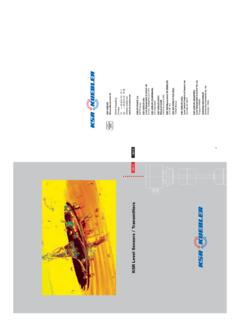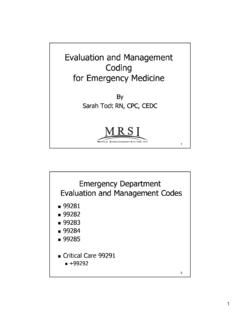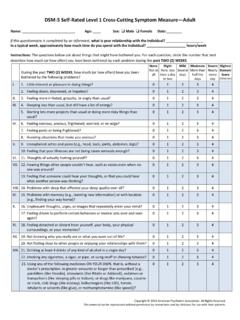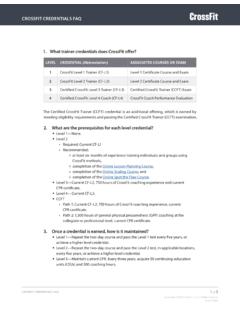Transcription of Advanced materials and design for board level EMI …
1 Advanced materials and design for board level EMI shielding Colin Tong Laird Technologies 1751 Wilkening Court, Schaumburg, IL 60173, USA. February 15, 2012. 2. Outline Principle of board level shielding (BLS). BLS shielding principle and materials selection guideline EMI shielding effectiveness testing methods Conventional BLS design and materials Metals Mechanical forming Casting Electroforming Form-in-Place (FIP) and Mold-in-Place (MIP). Molded plastics with metallic coating or painting Emerging BLS materials and future trends Conductive hybrid composites Absorbing materials Nano-composites Conclusions 3. Basic principle of board level shielding Based on Faraday cage principle, BLS can be designed with different forms, depending on the application requirements and mounting methods. Shell Equatorial plane Ventilation Five-sided holes can E[V/m]. Mains DC power filter filter Equipment Typical 5 sided metal can is used to form 6 sided shield through the attachment PCB with Signal filters for /connection to the ground ground plane PCB tracks plane on PCB.
2 4. Major functions of BLS. Shield different zones of a device from each other Cover it no inside EMI escape, and no outside EMI entering Ground/seal it no EMI leakage Manage system heat dissipation Minimize real estate used Minimize weight and cost Key factors for effective shielding material Geometry Termination Electrical conductivity/permeability/ Holes Shield- board interface permittivity Slots Connectivity Wall thickness/surface coating Gaps Joining/Mounting methods Thermal conductivity Environmental compatibility Manufacturability Cost usually dominates material selection for BLS. 5. WAVELENGTH AND FREQUENCY RELATIONSHIP EMI shielding materials are Wavelength [m]. 100 designed to harness, capture, Wavelength [mm] = 300 /f [GHz]. and ground the EMI energy 10. 1 Absorbing materials are designed to attenuate and 1 GHz has a wavelength of 300 mm absorb electromagnetic energy, 1 10 100 1000 10000 and convert it into heat Frequency [MHz].
3 Visible m m Light 106m 103m 1m 1mm Wavelength ( ). Gamma Rays Infrared Cosmic Rays Common EMI Shielding Range Soft X-rays Hard X-rays Ultraviolet VHF. UHF. FM. AM. Power Near Far Radio waves Microwaves 1 103 106 109 1012 1015 1018 1021 1024. Frequency (Hz). High conductivity High permeability materials Hydrides, metals, hydrogenous materials composites or other emerging Absorbing materials /waveguide structures materials Composites, laminates, multilayer functional materials , and/or nano-structures Different materials are usually suitable to different frequency ranges. Composites with hybrid structures can be future universal shielding materials 6. EMI shielding principle of conductive materials Incident Wave E0, H0. Absorption SE = R +A +B. Loss, A.. Reflection RE = + 10 log Transmitted Wave f 3r 2 . Loss, R E1, H2. fr 2 . RH = + 10 log Internal Reflection.
4 F . R P = 168 10 log Second Re-reflected . Reflection loss term Where RE, RH, and RP are the reflection losses for the electric, magnetic, and Skin plane wave fields expressed in dB; is E0, H0. depth, . the relative conductivity referred to Remaining field copper; f is the frequency in Hz; is the strength, E1, H1. 37%E0, H0 relative permeability referred to free space; r is the distance from the source 0 Distance from shield edge, t to the shielding in m. Reflection loss depends on the distance of the EMI source to the material (different for electric, magnetic, and plane waves), material electrical conductivity, and the frequency of the incident wave. 7. Absorption Loss Armstrong, K. E1=E0 e-t/ , and H1=H0 e-t/ . The distance required for the wave to be attenuated to 1/e or 37%. is defined as the skin depth, . 1. =. f . 100. Aluminum Stainless A = 20ln (t/ ) = 131 t f 1.
5 Minimum Thickness (inches). Minimum Thickness (mm). 10 Steel 1. Where A is the absorption or penetration loss expressed in dB; t is the thickness of the shield in mm; f is frequency in MHz; is relative permeability Typical plating thickness (1 to copper); is conductivity relative to copper in %IACS. Copper Mild Steel 10 100 1000 1k 10k 100k 1M 10M 100M 1G 10G 100G. Frequency (Hz). Absorption loss depends on material thickness, permeability, electrical conductivity, and the frequency of the incident wave. It is the same for all electromagnetic waves. 8. Effect of Apertures on Shielding effectiveness Electromagnetic fields Honeycomb waveguide SE (dB) = 20 log (fc/f )+ h/d -10log n Shield with Greater leakage d h where n= total number of cells, and f is apertures from bigger frequency and not more than fc/10. apertures Waveguide For a round hole s SEdB 102 -20 log( dfMH) + 30 (t/d) | d< /2.
6 D Number n ventilation holes (if s < /2, d > /2, and s/d <1). SE (dB) 20 log ( /2d) 10 log n h w For a regular shaped slot t SEdB 100 -20 log( wfMH) + 20log[1+ln(w/h)] + 30 (t/w) | w< /2. where w is length of slot and w>h and w>>t; is wavelength in meter; fMH is frequency in MHz. 9. Example: Calculated shielding effectiveness difference with different corners Wavy Corner Wrap Around Corner The longest dimension of the aperture limits or dominates the BLS shielding effectiveness. EMI shielding effectiveness testing methods MIL-STD-285 Shelters - Withdrawn NSA 65-6 and 73-2A Shelter SE measurements MIL-DTL-83528 Conductive Elastomer EMI Gasket Radiated Field and DC Volume Resistivity IEEE STD 299 Shelters (replaced MIL-STD-285). IEEE STD 1302 Guide to EMI Gasket Test Methods ASTM D4935 Planar materials - Withdrawn ASTM E1851 Shelters (duplicates MIL-STD-285).
7 SAE ARP 1705 EMI Gasket Transfer Impedance SAE ARP 1173 EMI Gasket Radiated Field EN 50147-1/VDE 0876-147-3 Enclosure SE Measurement IEC 61000-5-7 Enclosures Degree of Protection IEC 61000-4-21 Reverberation Chamber Test Techniques SCTE 48-1-2006 GTEM Cell Tests EMSCAN. 11. EMSCAN functionality and configuration 12. EMSCAN example 1 Absorbing material 13. EMSCAN example 2 Waveguide 14. Conventional BLS design and materials Shielding Type Mount/installation Features Shielding effectiveness (200 kHz to 5 GHz). Soldered over PCB Pick and place assembly Metal cans with surface mount with reflow process 40 - 100 dB. technology Conductive plastic Pin, screw or snap-on Mold to shape, with covers mount over PCB suface plating or conductive 30 - 100 dB. painting Robotic dispensing Crosstalk and perimeter Form-in-place on thin-walled BLS/ shielding 70-120 dB. enclosures Mold-in-place Conductive elestomer Component shielding molded over frames of and grounding 70 - 120 dB.
8 BLS/enclosures Proper selection of BLS systems depends on the balance of performance, reliability and cost 15. Metals Mechanical forming - Bending, stamping or drawing - Tin plated CRS, SS, Al, or Cu alloys - Nickel silver Cast Al, Mg or Zn Electroforming Mechanically formed metal cans are the low cost and most common used BLS especially with high volume production 16. CRS with composite coatings Tin whisker can be a concern for tin plated CRS. BLS. Mitigation practices include thicker tin coating, nickel underplate, annealing, and alternative coatings, etc. To alleviate the tin whisker growth concern and Special resin film designed for provide relatively low cost BLS, Chromate- free electrogalvernized steel (ZE-38) and ECO-TRIO oxidation-protection coating good solderability steel, have emerged as promising BLS shielding Relatively high surface materials .
9 Conductivity Not subject to whiskers Zn Substrate Zn 17. Die casting for BLS/Enclosures Major advantages - Durable, robust enclosure solution - Match with environmental sealing (space gaskets, including FIP, MIP etc.). - Good for thermal dissipation Disadvantages - Heaviest BLS/enclosure ( minimum thickness mm). - Draft requirement means sloped sidewalls - Die tooling cost is a major concern for small scale production Die casting materials typically include Al, Mg, and Zn Al has good corrosion resistance and mechanical properties, high thermal and electrical conductivity, and strength at elevated temperatures Zn is the easiest alloy to cast because of its low melting point, which is economical for production of small BLS parts Mg is the lightest alloy in common use 18. Electroforming Electroforming is a special fabrication method for BLS products with requirements for very small, very thin, very fine or very precise dimensions and patterns.
10 ( ). Handling design complexity is a further key strength of electroforming. By growing components in nickel or other metals on a mandrel, features and tolerances can be managed automatically. Minute components and complex features that cannot be achieved by any other manufacturing method may be produced by Electroforming. A wide variety of shapes and sizes can be made by electroforming, but the principal limitations are (a) shaping of mandrel; and (b) being the need to separate the part from the mandrel. 19. Form-in-Place (FIP). FIP is a robotically controlled dispensing process to apply conductive shielding gaskets on BLS, enclosures, covers and components, which offer cost savings in the form of reduced raw materials , labor, and assembly time. FIP gaskets are typically comprised of a foamed, gelled, or unfoamed elastomer resin, used as carrier for conductive fillers.







